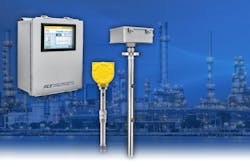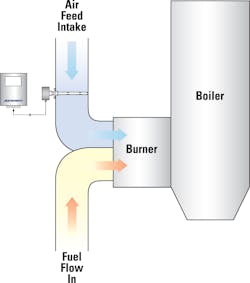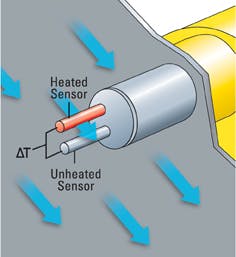Case Study: Refinery improves boiler air-to-fuel mixture performance with help from a multipoint thermal flowmeter
A major oil refinery’s plant team ran into challenging issues when they attempted to optimize their large primary boiler system, which initially perplexed the plant’s process engineers. After extensive study, it was determined there was a problem controlling the boiler’s burner air-to-fuel mixture ratio. The air flow measurements used by the system were inaccurate and erratic as well, which had negated previous efforts to enhance the boiler’s efficiency.
This boiler system’s design included a large, high-capacity air feed intake duct sending air to the boiler’s burner. Accurately measuring the intake air flow rate is important to providing the most efficient mixture of air and natural gas at the burner in any boiler system. The more efficient the air-to-fuel combustion ratio control, the less gas is consumed and with the least amount of off-gas, which reduces operational costs and the plant’s environmental footprint.
The issues
The exceptionally large boiler system’s primary duct limited the number of flowmeter technologies that the plant’s process team could consider. In addition, the installation location of the boiler system and piping was less than ideal. The air flow rate at startup also was significantly less than the flow rate during normal operation, which required an air flowmeter with a high turndown ratio.
Furthermore, the large air intake duct was only partially covered and allowed rain and dust into the duct. In addition, there were dense arrays of noise silencer tubes in the duct that restricted the installation of flow sensors to narrow passages between the tubes.
For a first attempt, the refinery had selected a multipoint differential pressure (DP) averaging flowmeter. This meter’s flow readings, however, were too unreliable. The DP-bar had only a narrow turndown, and the small orifices in the device were frequently clogging with dust particles, which resulted in excessive downtime and frequent unplanned maintenance.
Considering the size and scale of the ducting, its open-to-the-elements environment and crowded set-up, the choices of air/gas flow measurement sensing technologies was restricted. Generally speaking, the larger the diameter of a duct, pipe or stack, the harder it is to measure the air flow accurately. In looking at the technologies that measure air/gas flow, only a handful of them can operate accurately and reliably under these demanding conditions.
The cost of inefficient boiler burner air-to-fuel mixtures can result in an ongoing major energy expense that makes plants uncompetitive. Inefficient boiler systems in major refineries can slow product throughput, affect product quality and increase costs. The process team at the refinery needed to find a more efficient answer to its boiler problem, which eventually required looking at alternative flowmeter technologies.
The answer
The refinery plant’s process and instrumentation engineering team contacted Fluid Components International (FCI) to explore an alternative flow measurement solution. FCI’s local representative and its applications engineering team reviewed the problems and suggested installing the MT100S multipoint thermal mass flowmeter (Figure 1).
The diameter of the MT100 meter’s multiple flow elements was small enough to fit between the duct’s silencers and the flow element’s adjustable insertion length allowed their measuring point to be set on site to optimize the dependability of the air measurements. In addition, because the MT100’s thermal flow elements have no orifices or moving parts to clog or foul, the cost and time of routine maintenance could be significantly reduced.
For superior accuracy in large diameter ducts, stacks and pipe, MT100 flowmeters can be supplied with up to eight flow rate sensors. The multiple sensors are inserted at various depths within a duct, pipe or stack, and their outputs are multiplexed and averaged to calculate the flow rate with high accuracy in the process line. They can be installed at multiple points around the process line as an array of single tap points or mounted across a mast.
The refinery’s engineering team was pleased to learn that the standard MT100 meter offers a large 100:1 turndown within a wide 0.07 NMPS to 305 NMPS (0.25 SFPS to 1,000 SFPS) flow range. This meter further provided accuracy of ±1.75% of reading, ±0.5% full scale, with 0.5% of reading repeatability, which collectively met or went beyond all of the refinery’s measurement performance objectives.
The MT100 transmitter’s local readout provided the refinery plant team with a state-of-the-art color LCD display. It continuously shows the flow rate in actual engineering units as a percentage of its range and in a trend graph whose time base is user selectable. The readout also continuously displays totalized flow, intake air temperature and the operational status of each flow sensor in the system.
The standard dual (two) analog outputs for the MT100 transmitter are a high-resolution, 16-bit 4-20 mA signal, compliant with NAMUR NE43, and a 0-1 kHz frequency/pulse. Standard digital bus communications include HART (FieldComm Group certified) and Modbus 485. A USB port for interface to PCs is also included. Optional bus communications available are Foundation Fieldbus and PROFIBUS-PA.
The meter’s electronics include a user-programmable data logger feature to which flow rate, temperature and totalized flow, as well as fault codes, can be recorded on a removable 8 GB microSD card. The instrument also features a 3-point precision calibration drift check, which can be initiated on user demand or programmed to run automatically.
Developed for stack and flue gas environmental monitoring applications, the MT100 multipoint meters are available with an optional Continuous Emissions Monitoring System (CEMS/CERMS) package, which adds special calibration checking routines.
Thermal dispersion technology
With this direct mass flow sensor technology, the multipoint thermal meter chosen by the refinery plant team also includes built-in, real-time temperature compensation. This capability ensures repeatable and reliable measurement even in applications where wide process temperature variations are present, such as large refineries in continuous operation throughout the year.
With no moving parts or orifices to plug or foul, this multipoint thermal mass flowmeter is immune to dust and dirt. This trouble-free sensing technology, with its rugged packaging, results in a virtually maintenance-free instrument.
Results
The refinery team reported that the newly installed MT100 multipoint flowmeters supporting the boiler system have been in continuous, successful operation for more than a year. The engineers have improved the efficiency of their plant’s boiler system, lowered its operational cost and reduced its environmental footprint. Installing FCI’s MT100 multipoint flowmeter has helped them optimize the boiler’s fuel-to-air mixture ratio with more accurate, dependable air flow measurement and eliminated unplanned maintenance.
Randy Brown is the executive director of sales and marketing for Fluid Components International (FCI). FCI is a world-leading manufacturer and innovator of flow and level measuring instrumentation utilizing thermal dispersion technology. Brown has been with FCI for 17 years. He has more than 40 years of experience working for top-tier manufacturers in process measurement and control and test/measurement instrumentation fields in various technical sales and marketing leadership roles. His background includes extensive experience in industrial temperature and flow measurement, electronics and network test equipment.
Randy Brown
Randy Brown is the executive director of sales and marketing for Fluid Components International (FCI). FCI is a world-leading manufacturer and innovator of flow and level measuring instrumentation utilizing thermal dispersion technology. Brown has been with FCI for 17 years. He has more than 40 years of experience working for top-tier manufacturers in process measurement and control, and test/measurement instrumentation fields in various technical sales and marketing leadership roles. His background includes extensive experience in industrial temperature and flow measurement, electronics and network test equipment.





